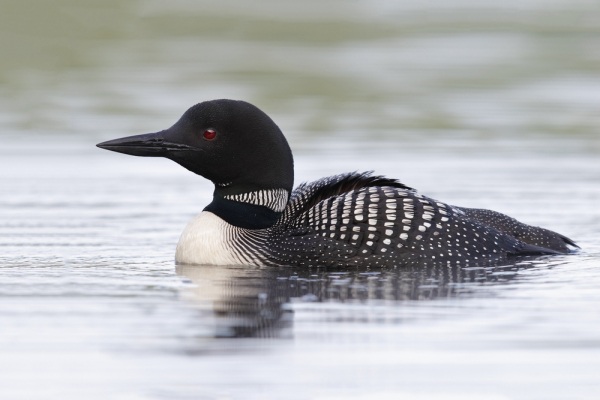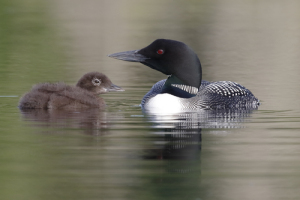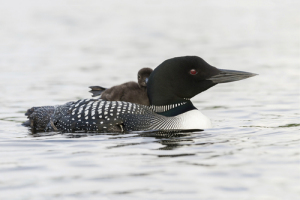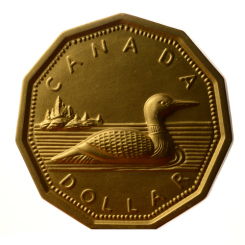
The Common Loon(Gavia immer), also known as the Great Northern Diver is a waterbird classified in the order Gaviiformes and the family Gaviidae.

Physical Characteristics
During the breeding season an adult Common Loon’s head and bill are black, its back is spotted with black-and-white, and their breasts are white. In the non-breeding season Common Loons are much duller in color. Juvenile specimens resemble non-breeding adults.
| Length | 66-91 cm(2’1.9”-2’11.8”) |
| Wingspan | 1-1.3 m(3’3.4”-4’3.2”) |
| Bill Length | 6.4-10 cm(2.5”-3.9”) |
| Weight | 2.2-7.6 kg(4.9-18.8 lbs.) |
*Subspecies
The Common Loon is classified as a monotypic species.
Range
The Common Loon’s breeding range is throughout most of Canada; Alaska, western and eastern Washington, northern Idaho, northwestern Montana, northwestern Wyoming, north-central North Dakota, upper great lakes (south through northern parts of Minnesota, Wisconsin and Lower Peninsula of Michigan), New York, and northern New England, Iceland and Greenland.
In the non-breeding season Common Loons can be found predominantly along northern Pacific and Atlantic coasts of North America.
Common Loons overwinter mainly along Pacific and Atlantic coasts in North America, including the Gulf of California and Gulf of Mexico.
Habitat
Common Loons inhabit lakes, ponds, reservoirs, and rivers.

Breeding
Common Loons usually nest on islands. The male chooses the nest site, and initiates the construction process; both the male and female share the building duties. The pair begin building the nest by making a mound out of dead vegetation, and then either the male or female crawls on top of the mound and shapes the interior to the outline of its body. Common Loon nests are about 55.9 cm(1’10”) wide, Common Loons often use the same nest site every year.
The clutch size is 1-2 eggs. The eggs are subelliptical to oval in shape, and are brown with dark specks. An egg weighs approximately 140 grams, and is 8.8 to 9 cm(3.46 to 3.54 inches) long, and 5.5 to 5.7 cm(2.17 to 2.24 inches) wide. The incubation period is 26 to 29 days. When the chicks hatch out of the eggs, they are covered in down; they are murky black and have a white belly. The chicks are able to swim a few hours after hatching; newly hatched chicks are semi-precocial, but will depend on their parents for food until they are 8 weeks old.
Diet
Common Loons eat mostly fish, but they also eat aquatic insect larvae, crustaceans, leeches, and snails.
Conservation Status
The Common Loon is listed as least concern.

Fun Facts
- The Common Loon is depicted on the Canadian 1 dollar coin; Canadians have nicknamed the coin the “loonie”.
- An adult Common Loon can eat up to 960 grams(2.1 pounds) of fish a day.
- The Common Loon can live for up to 29.8 years.
- Common Loons are quite adept at swimming; they often allow their chicks to ride on their backs.
